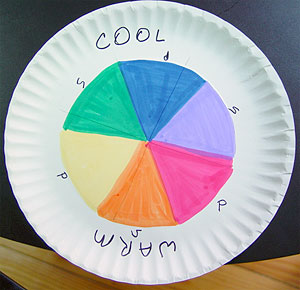Third Grade Art Lesson 4
Learning Basic Color Theory, The Color Wheel
Objective:
The student will know the primary, secondary, warm, and cool color schemes. The student will create a color wheel.
Materials:
A paper plate, markers
Procedure:
We want to begin today's class by looking at basic color theory. Knowing a little about color will help you to make better color choices in your art work. Let's begin with the basic primary colors. There are 3 primary colors: red, yellow, and blue. These colors are called primary because they are first and most important colors because we cannot use any other colors to mix them. However, with these 3 colors, we can mix all other colors. The secondary colors are colors created by mixing 2 primary colors together. Mixing red and yellow we get orange; mixing red and blue we get purple; and mixing blue and yellow we get green. Let's begin making our color wheel, using the primary and secondary colors. The color wheel is in a circle so that we can read it for information. We will put the primary colors down first. We will need six equal sections of the circle. In each of 3 alternating sections, put red, yellow, and blue. Fill in the secondary colors between the two primary colors used to make that color. For example, orange should go between red and yellow and so on. Use your markers carefully. Do not scribble as this dries out your marker and does not create neat work. Once your color wheel is complete you'll notice we can divide a line down the center. On one side of the line we find blues, greens, and purples. These are called cool colors. Cool colors tend to recede or go back into space. On the other side of the line you see your reds, oranges, and yellows, which are called warm colors. Warm colors tend to jump out into space. So when you want something in particular to stand out, it will always be wise to use warm colors in coloring it in. Go around the outer edge of your color wheel and label with a W or a C the warm and cool colors.
Conclusion:
Call out basic primary and secondary colors and have the students tell you if they are warm or cool and if they are primary or secondary. Have the students store their color wheels in a place where they can use them for further reference.
Artwork and Examples used in this lesson

Color Wheel













